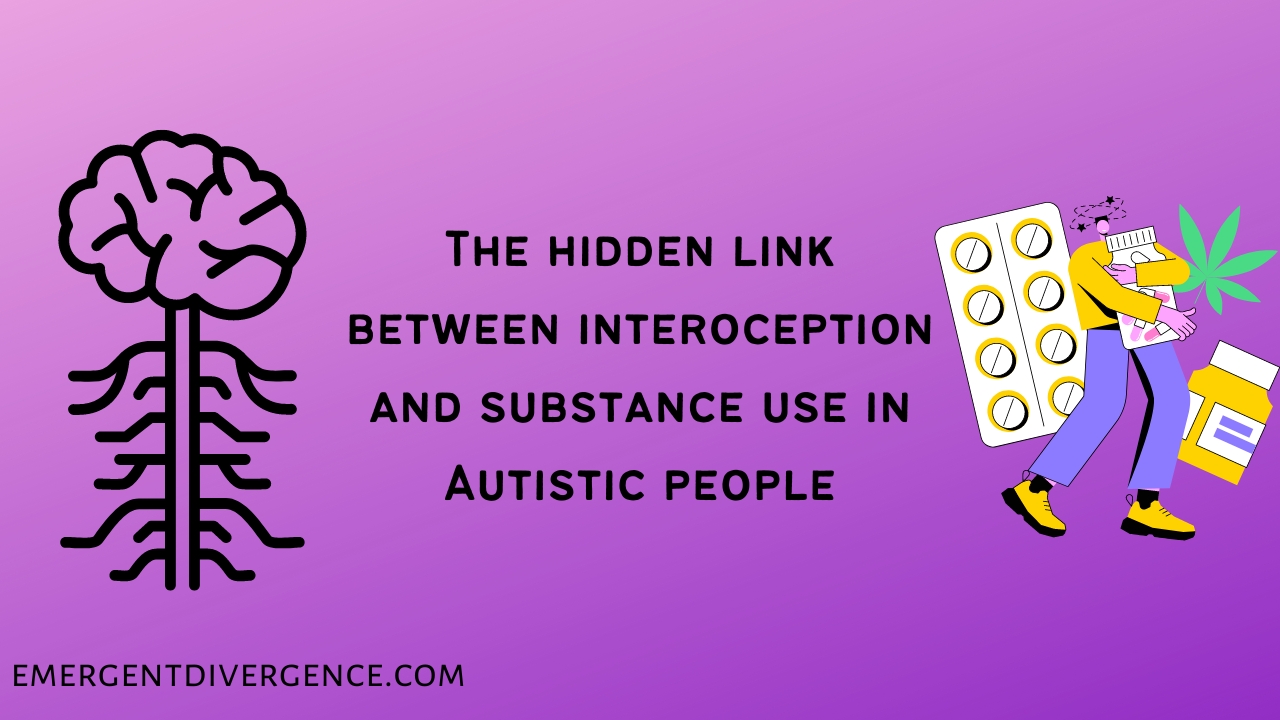Interoception and Autism: A Hidden Link to Substance Use?
Autism and substance use is an area that received little discussion in wider society. In my own experience, their is an assumption that Autistic people are less likely to use drugs, however growing bodies of research are beginning to show what I have said for many year; substance use is a relevant discussion with regards to Autistic culture. Research has even suggested that Autistic people are nine times more likely to report self-medicating with recreational drugs (Weir et al, 2021). One of the overlooked aspects of this is the impact of differences in our interoception.
What is interoception and why is it relevant to autism?
Interoception is the sensory system that allows us to feel what is happening in our body. It tells us when we are hungry, or our heart is pounding, it even tells us what emotion we’re feeling based on internal sensations. This awareness of the signals within your body allows you to know how you’re feeling and how safe a situation feels (Mahler, n.d.).

Many Autistic people report differences in their interoceptive sense (Neff, n.d.). These differences can lead to issues like alexithymia, relevant to discussions of autism as a potential explanation in our difficulty identifying and articulating our emotional state (Gray-Hammond, 2023a). Around half of Autistic people are reported in literature to experience Alexithymia (Kinnaird et al, 2019).
Knowing how we are feeling in a given situation allows us to know if we are safe, overwhelmed, in discomfort, and a wealth of other information. Alexithymia essentially means we can not regulate our emotions effectively in environments.
Why is this relevant to substance use in Autistic people?
Autistic people are known for self-stimulatory behaviour (AKA stimming). Much as an Autistic person can stim by flapping their hands or repeating words and sounds, they can also stim with their interoceptive sense. If a person struggles with their interoception, they might engage in activities that trigger particular interoceptive experiences (Gray-Hammond & Adkin, 2023).
Interoceptive differences also affect our motivation to use or avoid drugs, with interoceptive differences being a growing field of research in substance use fields (Paulus et al, 2013). So Autistic people are known to experience interoceptive differences, and be more likely to self-medicate their mental health. They are also more likely to experiences differences in their motivation to use drugs due to differences in their interoception.
Autism and substance use: The reality
Autistic people can use drugs and alcohol to induce feelings, or shut them off. For an Autistic person who is alexithymic, this might be highly attractive. Drugs give the Autistic person control of their emotions, which may come with a heavy energy burden to regulate, not to mention the ability to camouflage their Autistic traits in a discriminatory and hostile world (Gray-Hammond, 2023b). Those same differences in interoception may also impact on our motivation to use or avoid drugs themselves. When we can’t integrate the information we need to feel safe, drugs can alleviate the distress that arises.
In order to support Autistic drug users, we have to be treating the whole issue, not just the visible parts. Sensory differences play a significant role in the lives of Autistic people, and as such we can not separate them from discussions of autism and substance use. In my opinion, drug users in treatment need occupational therapy support as standard, particularly at the intersection with autism.
We can not forget that our sensory world forms the majority of our experience of life, therefore differences in this world mean that our engagement with substance use and recovery will also have differences. This is just one of the many ways that Autistic people are disadvantaged by the neuronormative structures in healthcare, and it’s time that we address it.
References
Gray-Hammond, D. (2023a). What is alexithymia? emergentdivergence.com. https://emergentdivergence.com/2023/06/30/what-is-alexithymia/
Gray-Hammond, D. (2023b). Understanding Autistic people’s relationship with drug use. emergentdivergence.com. https://emergentdivergence.com/2023/11/16/understanding-autistic-peoples-relationship-with-drug-use/
Gray-Hammond, D. & Adkin, T. (2023). Creating Autistic Suffering: Interoceptive stimming or “challenging behaviour”?. emergentdivergence.com. https://emergentdivergence.com/2023/09/18/creating-autistic-suffering-interoceptive-stimming-or-challenging-behaviour/
Kinnaird, E., Stewart, C., & Tchanturia, K. (2019). Investigating alexithymia in autism: A systematic review and meta-analysis. European Psychiatry, 55, 80-89.
Mahler, K. (n.d.) What is interoception? kelly-mahler.com. https://www.kelly-mahler.com/what-is-interoception/
Paulus, M. P., Stewart, J. L., & Haase, L. (2013). Treatment approaches for interoceptive dysfunctions in drug addiction. Frontiers in psychiatry, 4, 137.
Neff, M. A. (n.d.) Autism, Interoception, and How to Improve Your Awareness. neurodivergentinsights.com. https://neurodivergentinsights.com/blog/autism-interoception
Weir, E., Allison, C., & Baron-Cohen, S. (2021). Understanding the substance use of autistic adolescents and adults: a mixed-methods approach. The Lancet Psychiatry, 8(8), 673-685.







